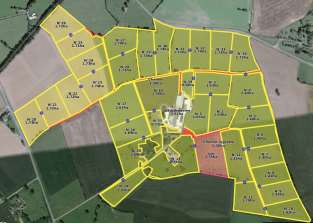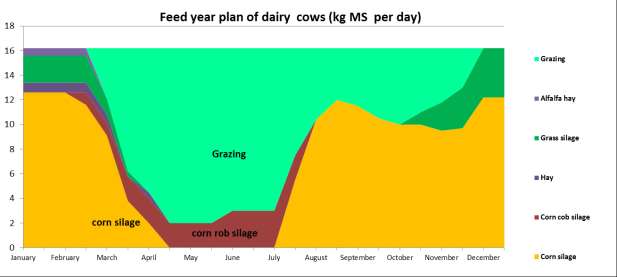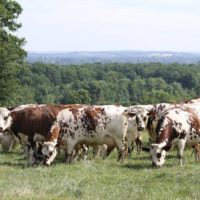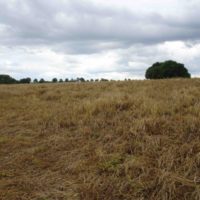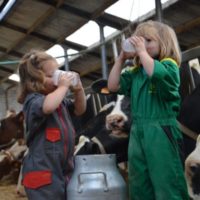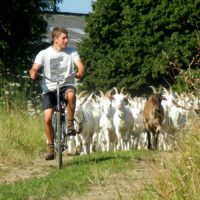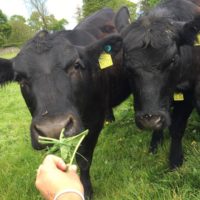Mob-grazing with a large herd
Farm: “GAEC du Tertre de Villeray”
Location: Mayenne, France
Case study
 Mob-grazing with a large herd (.pdf)
Mob-grazing with a large herd (.pdf)
Description
Background
This farm is a family business with five partners located in the north of Pays de la Loire, in Mayenne district. It’s a specialist dairy farm with cattle rearing. The dairy herd is composed by 165 Norman cows, they produce 1.1 million litters of milk. Twenty or so oxen are fattened on pasture each year to run permanent grassland area.
The 330 ha of agriculture area are composed of 218 ha of forage area and 112 ha of annual crops (wheat, barley and rapeseed). The main forage area is composed of 69 ha of corn silage (whole plant is harvested or only corn cob ensiled), 71 ha of temporary grasslands and 78 ha of permanent grasslands.
The main objective of farmers is to improve working conditions (research of simplicity, comfort and efficiency) without decreasing economic results. They want to reduce feeding cost by increasing grazing in cow diet. They have increased grazing area and have implemented a one-day (24 hours) rotational grazing management.
Detailed description
Increasing of grazed grassland area
The grazed grassland area allocated to dairy cows increased by twenty hectares between 2017 and 2018. 56 hectares are available for grazing 165 dairy cows.
Implementing a new pasture management to improve grass utilization
Farmers have implanted mob-grazing to improve grass utilization: a rotational daily grazing management. Before according to the plot size, cows have been moved every 3 to 7 days. Now, they are moved in a new plot every day. Farmers divided pasture area into 33 plots of 1,70 ha. They used a mobile app “Field area measure” to locate fences. In each plot, the entrance and exit are different. Water troughs are moved away from the entrance of the plots. New cow paths have
been laid out to drive cows to new pasture area. Purchasing costs are estimated to
Grazing management
Grazing is managed with the help of sward height. Grass heights are measured weekly in each plot with a grassmeter. Farmers put cows into paddock when sward height is 10 or 12 cm. Cows enter a new paddock morning or evening interchangeably. They are grazed to a target sward height of 5 cm. In late spring, when there is too much stem and some ears, farmers implement « topping », they cut the grass before the cows graze. Cows are supplemented with 2 or 3 kg of corn cob silage while the part of grazed grass is the highest to maintain the level of dairy production.
The farmer register his practices in a grazing schedule: the number of grazing animals, the grass quality, the severity of grazing, forage and concentrate complementation.
Results
The farmer is satisfied with his new grazing management. Grazing was more homogeneous than before. Plots were grazed out better by moving water troughs. Dairy cows move easily. It’s easier to fetch the cow out a small plot.
The grass intake is better: 7,3 tons per hectare on average, from 4,7 to 11,6 tons according to the paddocks.
The increase of grazed grass part of cow diet has been achieved by increasing area available for grazing and a better pasture management. In 2018, the turnout was done 1,5 months earlier than previous years (on February, 27th against on mid-April).
Grazed grass makes up 40 % of dairy cow’s diet in annual average. It makes up between 50 and 60 % of cow’s diet during grazing period and near 90 % in spring.
50 tons of soybean cake have been saved.
Recording data (grazing plan, grazing time, supplementation, grass intake…) makes farmers more aware on possible improvements of their grassland management, particularly it allows them to identify the less productive plots which need to be renewed.
This new grazing management was implemented in 2018. Beyond the realized soybean economy, economic results are not yet available (accounting closing on April, 30).
Adoption criteria
The temperate oceanic climate is in favour of grass growth (760 mm of annual rain). A large area is available to cattle grazing: 60 hectares around the barn. The entrance of the farthest grazed plot is 900 meters from the dairy building. Soil diversity is well suited to livestock grazing system and allows a long grazing period. Some soils with a good bearing capacity allow an early turnout and the grazing period could be longer over summer according to deep loamy soils.
The farm is included into the Pays de la Loire grass monitoring network. It is established by the chambers of agriculture. Sward height is measured weekly during the grazing season by a technical advisor and the data were used to calculate grass growth. Thereby, farmers have the data to manage grazing.
Beyond these elements, the adoption of this system comes first and foremost by the breeder’s motivation. His aim is to graze his cows rather than driving tractor to feed them.
Farmers accept a lower dairy yield per cow to improve feeding cost. Their aim remains to produce their milk quota by increasing the number of dairy cows on grazing period, and not overloading the building during winter period.
Improvements, threats, future prospects
The farmer needs to confront his system to different climatic years. Using different plots daily and nightly could be the next step in the improvement of grazing management. A special attention must be given to water network, especially to the size of the water troughs. In the farm, some water troughs are too small and need to be changed before the next grazing season. Paths are also very important to achieve easy cow traffic.
The milk is delivered to a dairy enterprise which have paid GMO-free milk 10 €/1000 l more since January the 1st. Farmers don’t use soybean cake anymore. It could be a new motivation for farmers to increase the grass part into dairy cow’s diet.
With their large herd, farmers think about separating dairy cows into batches according to their lactation curve, in order to adjust the level of supplementation.
Additional information
| Farming system | conventional farming |
|---|---|
| Domains of innovation | grazing management system |
| Main types of animal | dairy cattle |
| Country | France |
| Product type | Case study |
| Language | English |

